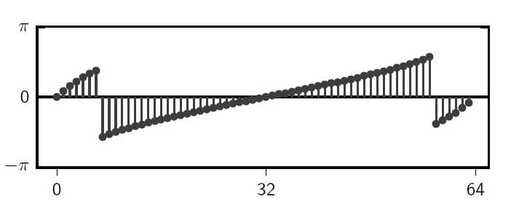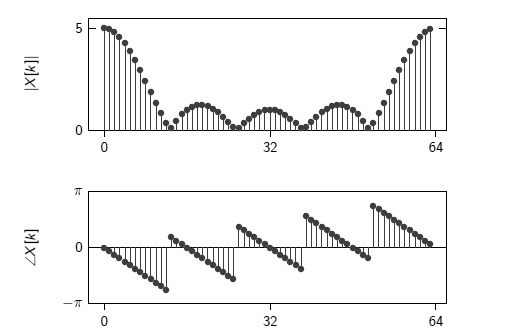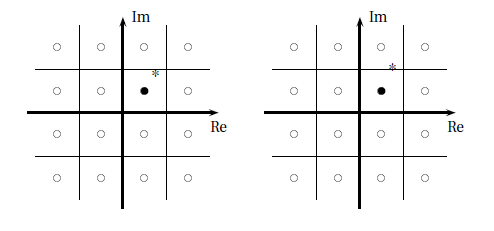
Signal Processing for Communications
by Paolo Prandoni and Martin Vetterli
Errata
Chapter 1:
- Page 1; (First page, first line and a typo: that's a good start!) Is a a formal description
- Page 4; line 11: the the side
- Page 10; Eq. (1.4): strictly speaking, the fraction is not defined for t = nT_s but here we implicity invoke the continuity extension used in the definition of the sinc (see 5.34)
- Page 13; the noise function is of obviously unknown
- Page 17; Line 7: the voice signal ends up buried
- Page 18; Further Reading, 7th line: integrated supplemented
Chapter 2:
- Page 20; Eq 2.1: $x[n] = ((n + 5) mod 11) - 5$
- Page 24; Eq 2.1: $x[n] = An example of (2.9) (2.10) is shown in Figure 2.5(d)
- Page 26; Section "Shift": "to the left" and "to the right" are inverted in the text. A delay is a shift to the right, while an advancement is a shift to the left.
- Page 29; Sec 2.2.1, Line 1: length N are is
- Page 29; Line 12: ans and
- Page 29; Line 14: are is
- Page 30; Line 2: always finite
- Page 32; Line 5: the the
- Page 36; Exercise 2.1, item (d): i = 0, 1, 23.
Chapter 3:
- Page 41; End of Section 3.1: Another important orthonormal basis for \mathbb{R}^N\mathbb{C}^N is the normalized Fourier basis...
- Page 44; Line 12 from bottom: norme
- Page 44; Line 9 from bottom: Cauchy-Schwartz
- Page 45; Line 10: separate separable
- Page 48; Eq. (3.36) and (3.37): the equations should adhere to a better formalism and be rewritten as: for (3.36): x \isin P and y \isin P => x + y \isin P; for (3.37): x \isin P and \alpha \isin S => \alpha x \isin P.
- Page 49; line 13 from the top: Alternatively, an linearly independent set of vectors...
- Page 50; Line 10 from the top: subscript l goes from zero to L-1
- Page 50; Eq. (3.46): \arg\min_{\hat{\mathbf{y}} \in P} \|\mathbf{y - \hat{y}}\|_2 = \mathbf{d}.
\sum_{k=0}^{K-1} \langle \mathbf{x}^{(k)}, \mathbf{y} \rangle \mathbf{x}^{(k)}.
- Page 54; Eq. (3.59): probably a better notation for the subscript of the sum would be l \in \mathcal{Z} / \{k\}.
Chapter 4:
- Page 61; Line 8: (with $N \neq 0$ obviously).
- Page 67; Line 16: oscillatory behavior at frequency $2\pi/k$, $(2\pi/N)k$ is contained in the signal;
- Page 69; Line 2: hot that of the original signal's
- Page 70; Figure 4.8, bottom panel shows the phase for the DFT of $\cos((2\pi/5) n)$. The correct phase plot is the following:

- Page 71; Figure 4.9: the figure got slightly mangled in the typesetting process. A more accurate version is the following:

- Page 73; 2nd formula: $/d\omega$ missing in the integral
- Page 73; Eq. (4.16): spurious "=" sign after "lim"
- Page 82; Line 6: Now we recognize in the last term important to recognize the last terms
- Page 86; Eq 4.73: [ [x[N-k] x[N-k+1] \ldots x[N-1] x[0] x[1] x[2] \ldots x[N-k-1] ]^T
- Page 89; Line 6 from the bottom: $x[n] = \delta[n-k]$ & $X[k] = e^{-j\frac{2\pi}{N}k}$ should be $x[n] = \delta[n-M]$ & $X[k] = e^{-j\frac{2\pi}{N}Mk}$
- Page 92; Line 3 from bottom: precised made precise
Chapter 5:
Chapter 6:
- Page 149; Eq (6.8): $X_1(z) = $.
- Page 149; Eq (6.9): $X_2(z) = $.
- Page 151; Line 18 (last equation): |x[n]z_0^n| <= |x[n]z_1^n| |x[n]z_1^n| <= |x[n]z_0^n|
- Page 151; Fig 6.1 (label): (b) anticausal (b) sequence
- Page 152; Line 8 from bottom: largest smallest magnitude
- Page 156; last line: it is easy to see that the poles zeros of the filter are...
- Page 157; Eq. (6.17): wrong exponent for z: (1-W_N^k z^{-k}) (1-W_N^k z^{-1})
Chapter 7:
- Page 173; 2nd line from the top: by using only $2N+1$ Fourier coefficients terms in the Fourier sum
- Page 173; Eq. (7.3): w[n] = \rect{n}{N} \rect{n}{2N}
- Page 174; 2nd bullet point: $\Delta=4\pi(2N+1)$ $\Delta=4\pi/(2N+1)$
- Page 174; line 4 (1st equation): in the convolution, the first factor should be H(e^(j\theta)) and not H(e^j\omega)
- Page 175; line 3 (1st equation): the argument of the integral should be W(e^j(\omega_0 - \theta)) and not W(e^j(\omega - \omega_0))
- Page 183; 3rd line from the bottom: polynomial degree $K$ $L
- Page 187; line 18: except possibly in $x=0$ $x=-1$ or $x=1$
- Page 187; line 20: the frequency response must be alternation alternating
- Page 191; line 6 from bottom: at $\omega = 0$ times divided by the length of the signal's support
- Page 192; line 14 from top cost/benefit tradeoff benefit-cost tradeoff
- Page 196; 2nd line after eq. (7.27): $M_r + 2M_c = M$ $M_r + 2M_c = M-1$; a little later: $N_r + 2N_c = N$ $N_r + 2N_c = N-1$.
- Page 198; Figures 7.24 to 7.27: all the $a$ coefficients in the filter structures should have a leading minus sign, as per eq. (5.47).
- Page 213; Exercise 7.8, item (c): The zero of the transfer function is at z_0 = 1.8 + 0.4j, not at z_0 = -1.8 + 0.4j.
Chapter 8:
- Page 221; line 4 from bottom: missing bracket: R_X[l, k] = E[X[l]X[k]]
- Page 226; Eq. (8.16): P_XY(e^(j\omega)) P_{XY}(e^(j\omega)) = \sum_{t = -\infty} {k = -\infty} ...
- Page 228; Eq. (8.19), first line: E[\sum_{k = 0} {k = -\infty} ...
Chapter 9:
- Page 238; Eq 9.6 $\FT{e^{j\Omega_0 t}} = 2\pi\delta(\Omega-\Omega_0)$
- Page 239; Equation (9.9): Eq. (9.9) the denominator of the first term in the right-hand side should be \Omega_N and not \Omega_s.
- Page 248; Equation (9.9): Second unnumbered equation after Eq. (9.9), first line, right-hand side: it should be \rect(\frac{\Omega}{2Omega_N}) (i.e. the denominator in the argument to the rect misses a leading "2").
- Page 249; Equation (9.22): it should be \rect(\frac{\Omega}{2Omega_N}) (i.e. the denominator in the argument to the rect misses a leading "2").
- Page 252; Lines 9, 10 and 13: replace $(1+\alpha)$ by $(2-\alpha$): "If we increase the frequency further, say to $f_0 = (2-\alpha)F_N$, we have
\[
x[n] = e^{j(2-\alpha)\pi n = e^{-j\alpha \pi n}
\]
..."
- Page 261; line 7: H(e^(j\omega)) = j\omega j\omega / T_s
Chapter 10:
- Page 280; Unnumbered equation after (10.6), 2nd line: there is a spurious "/" sign before the "2" in the denominator of the first term.
- Page 290; Exercise 10.3: To solve this exercise the student needs the material in Chapter 11 first.
Chapter 11:
- Page 297; Section 11.1.3, first equation: it should be X_{2D}(z)=\frac{1}{2}[X(z^{1/2})+X(-z^{1/2})].
- Page 315; Equation (11.20): it should be X_c(j\Omega) = \frac{\pi}{\Omega_N} I(j\pi\Omega/\Omega_N) X(e^{j\pi\Omega/\Omega_N}).
Chapter 12:
- Page 341; Formula for PAM power is missing a leading factor of two; final result is $\frac{2^M(2^M+3)+2}{12}$
- Page 345; Figure 12.14 got mangled in the typesetting. It should be like this:

- Page 350; Figure 12.19 signal at the ouput of the diagram should be $\hat{c}[n]$
- Page 358; Eq. 12.35 $x_{ND}[n] = \sin((2\pi \beta) n)$ $x_{ND}[n] = \sin(((2\pi/ \beta) n)$
- Page 360; Eq 12:39 \hat{x}_\tau(n_0; \tau) \hat{x}(n_0; \tau)
- Page 361; Eq 12.41: x_\beta[n] = x(nT_s - n\frac{1-\beta}{\beta}T_s) = x(nT_s - n\tau T_s) x_\beta[n] = x(nT_s + n\frac{1-\beta}{\beta}T_s) = x(nT_s + n\tau T_s)
- Page 361; items 3 and 4: The prime ( ' ) should goon \tau and not on x . For instance in the very last line: $x_{\beta}[4] =
x_{\tau'}[b]$
- Page 362; items 3 and 4: The prime ( ' ) should goon \tau and not on x .



